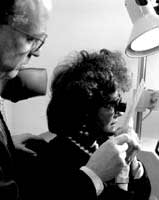FOCUS ON LOW VISION
Answering Readers' Questions
By Steph De Long
In this month�s column, we have invited several low vision practitioners to answer readers� questions.
More AMD Patients
Q I am seeing twice as many macular degeneration patients as I did five years ago. Are the numbers rising that dramatically?
A There are many reasons why clinicians are seeing more patients with ARMD.
First there�s an increase in the aging population. In addition, there has been a dramatic increase in the awareness surrounding new treatments, research, nutrition, and high-tech devices for AMD. There are also organizations that devote a great deal of time educating the public as well as the professional.
The 65 and older population has grown from 25.5 million in l980 to 34.9 million in 2000. The 85 and older group has gone from 2.2 million in l980 and 4.3 million in 2000.
Even more startling, it is predicted that the 65 and older group will increase to 56.2 million in 2020, while the 85 and older group is projected to grow to about 6.8 million by 2020.
|

|
|
|
Photo courtesy of Lighthouse International. |
|
It is also known that the incidence of macular degeneration will increase with this rise in the aging population. In fact, it is estimated that five percent of people 65 and older in the United States have some visual impairment as a result of macular degeneration.
And among individuals age 75 and older, more than one-third have macular degeneration.
For more information, contact: The Federal Interagency Forum on Aging-Related Statistics Older Americans 2000 (www.census.gov/population/www/projections/natproj.html); The American Optometric Association (www.aoanet.org); Lighthouse International (www.lighthouse.org); or AMD Alliance International (amdalliance.org).
�Bruce P. Rosenthal, O.D., chief of Low Vision Programs, Lighthouse International; and chairman, AMD Alliance International
Getting M.D. Referrals
Q Despite my long-term relationships with M.D.s in my area, I have a real problem getting them to refer low vision patients. What can I do?
A It is hard to develop a comfortable referral relationship. It takes time, and time is also the problem in the office. The retinal specialist, for instance, will not be able to take five or 10 minutes to explain why the referral is being made and what the expected outcome will be.
The key is to make your low vision practice an extension of the M.D.�s or O.D.�s office and the referral of patients as easy as possible for the doctor and all office staff. You can leave brochures in the M.D. office regarding the low vision exam so all that needs to be done is hand the patient a brochure. A system can be set up where the M.D. faxes a referral to your office with the patient�s name, phone and diagnosis, and your staff calls and sets up the appointment on behalf of the referring doctor. All the referring doctor has to do then is tell the patient a referral is being made to a specialist (you) and that the specialist�s office will call and answer their questions.
If your low vision practice is somewhat independent of your private practice (i.e., it has another name), consider putting the referral doctor on an advisory board that�s listed on the brochure. That may make it easier as the referral would be seen as an extension of the primary doctor�s vision care.
Don�t forget, however, that the most important person in the referral is the chief office technician, ophthalmic assistant or manager. Treat them well!
�Randy Jose, O.D., FAAO, director, Center for Sight Enhancement, University of Houston
When Glare�s a Problem
Q There are many different tints available for controlling glare. How do I know which one is best for a particular patient? And, how would you suggest I demonstrate the options?
A The easiest way to answer your questions is to explain what I do in my practice. First, I spend time talking with the patient and asking very specific questions. I ask, "When are you bothered? Outside? Do you have trouble with curb and sidewalk curves? Details? Are things fuzzy outside? And what about inside? Do you have trouble seeing price tags in stores? Do lights bother you? At home, do you ever have to draw the shades when the sun is up?"
Once I determine their problems, I start demonstrating products for the area where they seem to have the most difficulty. If it�s being outside, then we go outside. I explain that the filters aren�t just sunglasses, so not only can they reduce glare but also improve acuity. I have them try a variety of filters outside�starting with the darkest and going lighter. If the filters don�t work, I try less expensive lenses and shields.
If the patient has problems indoors, too, then we go to a lighter filter. I ask them to keep the frame on and then we go back inside. I take them to a room we have that has lots of fluorescent light and ask if that bothers them. I have them try to read a price tag.
In most cases, we find a product that works both indoors and out. And, if they say they use a computer, then I have them try glare control lenses on a computer in the office.
The most critical thing is to work with the patient under lighting conditions that approximate their environment.
�Steven I. Bennett, O.D., FAAO, Ann Arbor, Mich.



